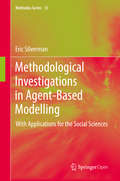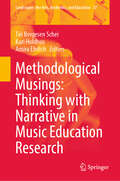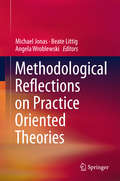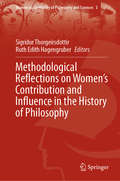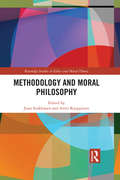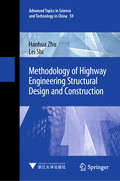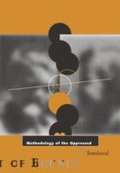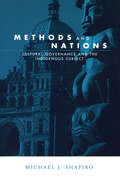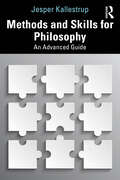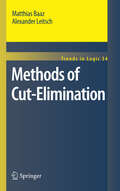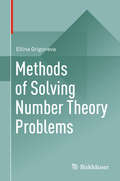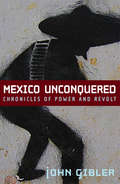- Table View
- List View
Methodological Investigations in Agent-Based Modelling: With Applications For The Social Sciences (Methodos Ser. #13)
by Daniel Courgeau Jakub Bijak John Bryden Eric Silverman Robert Franck Jason Hilton Jason NobleThis open access book examines the methodological complications of using complexity science concepts within the social science domain. The opening chapters take the reader on a tour through the development of simulation methodologies in the fields of artificial life and population biology, then demonstrates the growing popularity and relevance of these methods in the social sciences. Following an in-depth analysis of the potential impact of these methods on social science and social theory, the text provides substantive examples of the application of agent-based models in the field of demography. This work offers a unique combination of applied simulation work and substantive, in-depth philosophical analysis, and as such has potential appeal for specialist social scientists, complex systems scientists, and philosophers of science interested in the methodology of simulation and the practice of interdisciplinary computing research.
Methodological Musings: Thinking with Narrative in Music Education Research (Landscapes: the Arts, Aesthetics, and Education #37)
by Kari Holdhus Tiri Bergesen Schei Amira EhrlichThis book focuses on narrative forms of research and inquiry in music education. As narrative approaches gain momentum, questions of methodology become salient. This research anthology highlights a diverse array of narrative methodologies and offers strategies for new researchers. The authors reflect transparently on how they did their narrative analyses, how they position themselves, and which narrative tradition(s) they align with. In this book, editors and authors aim at conceptualizing and clarifying narrative approaches in music education, showing how narrative thinking can be combined with theoretical stances such as discourse analysis and phenomenology. The book demonstrates how awareness of multi-layered dialogical meaning production can inform narrative research. It also addresses performative narratives of musicians and educators. The authors forefront narrative research methods as highly valuable for arts-based research, because of their potential for being expressive and performative, as well as conceptual.
Methodological Prospects for Scientific Research: From Pragmatism to Pluralism (Synthese Library #430)
by Wenceslao J. GonzalezThis book highlights the existence of a diversity of methods in science, in general, in groups of sciences (natural, social or the artificial), and in individual sciences. This methodological variety is open to a number of consequences, such as the differences in the research according to levels of reality (micro, meso and macro), which leads to multi-scale modelling and to questioning “fundamental” parts in the sciences, understood as the necessary support for the whole discipline. In addition, this volume acknowledges the need to assess the efficacy of procedures and methods of scientific activity in engendering high quality results in research made; the relevance of contextual factors for methodology of science; the existence of a plurality of stratagems when doing research in empirical sciences (natural, social and of the artificial); and the need for an ethical component while developing scientific methods, because values should have a role in scientific research. The book is of interest to a broad audience of philosophers, academics in various fields, graduate students and research centers interested in methodology of science.
Methodological Reflections on Practice Oriented Theories
by Beate Littig Michael Jonas Angela WroblewskiThis volume presents a comprehensive overview of methodological issues and empirical methods of practice-oriented research. It examines questions regarding the scope and boundaries of practice-oriented approaches and practice theory. It discusses the potential advantages and disadvantages of the diversity resulting from the use of these approaches, as well as method and methodology-related issues. The specific questions explored in this volume are: What consequences are linked to the application of a praxeological perspective in empirical research when it comes to the choice of methods? Is there such a thing as an ideal path to follow in praxeological empirical research? What relationship is there between qualitative and quantitative approaches? What differentiates practice-based social research from other perspectives and approaches such as discourse analysis or hermeneutics? The contributions in this book discuss these questions either from a methodological point of view or from a reflective perspective on empirical research practices.
Methodological Reflections on Women’s Contribution and Influence in the History of Philosophy (Women in the History of Philosophy and Sciences #3)
by Sigridur Thorgeirsdottir Ruth Edith HagengruberThis book introduces methodological concepts aimed at including women in the canon of the history of philosophy. The history of women philosophers is as long and strong as the history of philosophy, and this holds true not only for the European tradition, as the research of women philosophers of the past shows. The phenomenon of ignoring and excluding women in 19th and 20th century views on the history of philosophy was a result of the patriarchal tradition that ostracized women in general. In this book, leading feminist philosophers discuss methodologies for including women thinkers in the canon and curricula of philosophy. How does the recovery of women thinkers and their philosophies change our view of the past, and how does a different view of the past affect us in the present? Studying a richer and more pluralistic history of philosophy presents us with worlds we have never entered and have never been able to approach. This book will appeal to philosophers and intellectual historians wanting to view the history of philosophy in a new light and who are in favor of an inclusive perspective on that history.
Methodology and Emotion in International Relations: Parsing the Passions (Interventions)
by Mira Sucharov Eric Van RythovenThis volume offers a state-of-the-art study of the diverse methodological approaches and issues in the study of emotions in international relations research. <P><P> While interest in emotion and affect in IR has grown in recent years, there remains an absence of sustained engagement with questions of methodology and method. Although much of the field holds the ‘emotions turn’ as laudable, it is commonly seen as facing serious, even prohibitive, methodological challenges. <P><P> Using a common framework for making discussions of methodology and emotion mutually intelligible, this work seeks to address this lacuna and will be of interest to students and scholars of international relations, research methods and IR theory.
Methodology and Moral Philosophy (Routledge Studies in Ethics and Moral Theory)
by Jussi Suikkanen Antti KauppinenMany ethicists either accept the reflective equilibrium method or think that anything goes in ethical theorizing as long as the results are plausible. The aim of this book is to advance methodological thinking in ethics beyond these common attitudes and to raise new methodological questions about how moral philosophy should be done. What are we entitled to assume as the starting-point of our ethical inquiry? What is the role of empirical sciences in ethics? Is there just one general method for doing moral philosophy or should different questions in moral philosophy be answered in different ways? Are there argumentative structures and strategies that we should be encouraged to use or typical argumentative patterns that we should avoid? This volume brings together leading moral philosophers to consider these questions. The chapters investigate the prospects of empirical ethics, outline new methods of ethics, evaluate recent methodological advances, and explore whether different areas of moral philosophy are methodologically continuous or independent of one another. The aim of Methodology and Moral Philosophy is to make moral philosophers more self-aware and reflective of the way in which they do moral philosophy and also to encourage them to take part in methodological debates.
Methodology of Highway Engineering Structural Design and Construction (Advanced Topics in Science and Technology in China #59)
by Hanhua Zhu Lei ShiThis book mainly studies the methodologies of structural design and construction for highway engineering, which are applicable to the overall control and the precise operation of engineering structures. It explores the method of comprehensive analysis, the simplification of complex problems, and the application of typical engineering tools. In turn, the book presents a number of innovative approaches, e.g. the coordinated control of structural deformation method, the theory of underground engineering balance and stability, and the soft soil foundation treatment of “bumping at the bridgehead.” These methodologies are then illustrated in typical cases and representative problems, explained from a practical standpoint. Examples in special settings are also discussed, e.g. highway construction in Tibet, and rebuilding after the Wenchuan earthquake. The book offers a valuable reference guide for all those whose work involves highway engineering design, construction, management, and scientific research.
Methodology of the Oppressed
by Chela SandovalIn a work with far-reaching implications, Chela Sandoval does no less than revise the genealogy of theory over the past thirty years, inserting what she terms "U.S. Third World feminism" into the narrative in a way that thoroughly alters our perspective on contemporary culture and subjectivity. What Sandoval has identified is a language, a rhetoric of resistance to postmodern cultural conditions. U.S liberation movements of the post-World War II era generated specific modes of oppositional consciousness. Out of these emerged a new activity of consciousness and language Sandoval calls the "methodology of the oppressed". This methodology -- born of the strains of the cultural and identity struggles that currently mark global exchange -- holds out the possibility of a new historical moment, a new citizen-subject, and a new form of alliance consciousness and politics. Utilizing semiotics and U.S. Third World feminist criticism, Sandoval demonstrates how this methodology mobilizes love as a category of critical analysis. Rendering this approach in all its specifics, Methodology of the Oppressed gives rise to an alternative mode of criticism opening new perspectives on a theoretical, literary, aesthetic, social movement, or psychic expression.
Methods and Criteria of Reasoning: An Inquiry into the Structure of Controversy (International Library of Philosophy)
by Rupert Crawshay-WilliamsFirst published in 2000. Routledge is an imprint of Taylor & Francis, an informa company.
Methods and Nations: Cultural Governance and the Indigenous Subject
by Michael J. ShapiroMethods and Nations critiques one of the primary deployments of twentieth-century social science: comparative politics whose major focus has been "nation-building" in the "Third World," often attempting to universalize and render self-evident its own practices. International relations theorists, unable to resist the "cognitive imperialism" of a state-centric social science, have allowed themselves to become colonized. Michael Shapiro seeks to bring recognition to forms of political expression-alternative modes of intelligibility for things, people, and spaces-that have existed on the margins of the nationhood practices of states and the complicit nation-sustaining conceits of social science.
Methods and Skills for Philosophy: An Advanced Guide
by Jesper KallestrupMethods and Skills for Philosophy introduces students to methodologies, strategies, heuristics and formal tools which are typically employed in contemporary analytic philosophy. This helpful resource gets the reader to engage with the analytical skills required to master postgraduate studies in philosophy.In conjunction with analysing texts, reflecting on arguments and trying to solve problems, the book will help instil in students the kind of understanding, knowledge and skills they need to succeed at the postgraduate level. More specifically, students will have a better grasp of how to pose a succinct research question and then critically pursue the proposed topic by engaging with relevant literature, reflecting on philosophical presuppositions, selecting suitable argumentative strategies and defending a preferred view against objections. Topics covered include: the nature and character of arguments conceptual analysis analytical truths logic and language models of explanation and reduction strategies and dialectics rational intuitions. Methods and Skills for Philosophy: An Advanced Guide provides a comprehensive and accessible introduction to philosophical methods. It is a must-read for advanced undergraduate or postgraduate students of philosophy, and also suitable for those studying postgraduate philosophy who have a background in other academic disciplines.
Methods in Analytical Political Theory
by Adrian BlauThis is the first book to explain how to use key methods in analytical political theory. The methods discussed include contractualism, reflective equilibrium, positive political theory, thought experiments and ideological analysis. Many discussions of political theory methods describe and justify these methods with little or no discussion of their application, emphasizing 'what is' and 'why do' over 'how to'. This book covers all three. Each chapter explains what kinds of problems in political theory might require researchers to use a particular method, the basic principles behind the method being proposed, and an analysis of how to apply it, including concrete principles of good practice. The book thus summarizes methodological ideas, grouped in one place and made accessible to students, and it makes innovative contributions to research methods in analytical political theory.
Methods in the Philosophy of Science: A User's Guide
by Adrian Currie Sophie J. VeiglA guidebook to methods and methodology, encouraging deeper engagement across the philosophy of science and beyond.The last twenty years have seen multiple methodological revolutions in the philosophy of science: There has been increased diversity concerning the questions asked, who asks those questions, who the relevant audiences are, and what the techniques and tools involved are. In Methods in the Philosophy of Science: A User&’s Guide, Sophie Veigl and Adrian Currie introduce this range of methods through both practical advice and philosophical reflection. Each chapter introduces the reader to a method or set of methods in the philosophy of science, discusses its advantages and limitations, and provides practical guidance on how to learn skills relevant to applying the method.The volume fulfills several critical roles. First, by introducing and discussing methods in the philosophy of science, the collection increases philosophers' awareness of methodological options—of particular importance for younger scholars who are often not exposed to the diversity of practice. Second, the collection's practical focus will aid established philosophers in diversifying their own methodological toolkits. Third, collecting this diversity serves as a ground for philosophical reflection on what we, as philosophers, take ourselves to be capable of. Fourth, the collection hopes to increase interdisciplinary links between philosophy and other fields by laying clear the methodological continuity and complement between them.
Methods of Argumentation
by Douglas WaltonArgumentation, which can be abstractly defined as the interaction of different arguments for and against some conclusion, is an important skill to learn for everyday life, law, science, politics, and business. The best way to learn it is to try it out on real instances of arguments found in everyday conversational exchanges and legal argumentation. The introductory chapter of this book gives a clear general idea of what the methods of argumentation are and how they work as tools that can be used to analyze arguments. Each subsequent chapter then applies these methods to a leading problem of argumentation. Today the field of computing has embraced argumentation as a paradigm for research in artificial intelligence and multi-agent systems. Another purpose of this book is to present and refine tools and techniques from computing as components of the methods that can be handily used by scholars in other fields.
Methods of Cut-Elimination
by Matthias Baaz Alexander LeitschThis is the first book on cut-elimination in first-order predicate logic from an algorithmic point of view. Instead of just proving the existence of cut-free proofs, it focuses on the algorithmic methods transforming proofs with arbitrary cuts to proofs with only atomic cuts (atomic cut normal forms, so-called ACNFs). The first part investigates traditional reductive methods from the point of view of proof rewriting. Within this general framework, generalizations of Gentzen's and Sch\"utte-Tait's cut-elimination methods are defined and shown terminating with ACNFs of the original proof. Moreover, a complexity theoretic comparison of Gentzen's and Tait's methods is given. The core of the book centers around the cut-elimination method CERES (cut elimination by resolution) developed by the authors. CERES is based on the resolution calculus and radically differs from the reductive cut-elimination methods. The book shows that CERES asymptotically outperforms all reductive methods based on Gentzen's cut-reduction rules. It obtains this result by heavy use of subsumption theorems in clause logic. Moreover, several applications of CERES are given (to interpolation, complexity analysis of cut-elimination, generalization of proofs, and to the analysis of real mathematical proofs). Lastly, the book demonstrates that CERES can be extended to nonclassical logics, in particular to finitely-valued logics and to G\"odel logic.
Methods of Logic (Fourth Edition)
by W. V. QuineThis widely used textbook of modern formal logic now offers a number of new features. Incorporating updated notations, selective answers to exercises, expanded treatment of natural deduction, and new discussions of predicate- functor logic and the affinities between higher set theory and the elementary logic of terms, Quine's new edition will serve admirably both for classroom and for independent use.
Methods of Metaphysics (Routledge Library Editions: Metaphysics #9)
by Alan WhiteOriginally published in 1987. This book comprises a critical exposition of the thoughts on metaphysics of the major philosophers of the tradition. It introduces the ideas of these philosophers to students but is of interest to teachers as well. The author begins with a survey of the metaphysical writings of Plato, Aristotle, Berkeley, Leibniz and Bradley, clarifying throughout the relation of their methods and results to those of science. He follows this with a careful study of the critical attitudes to metaphysics espoused by Kant, Wittgenstein and the Logical Positivists. In the final section he scrutinizes the attempts by Collingwood, Wisdom and Lazerowitz to rehabilitate metaphysics.
Methods of Solving Complex Geometry Problems
by Ellina GrigorievaThis book is a unique collection of challenging geometry problems and detailed solutions that will build students' confidence in mathematics. By proposing several methods to approach each problem and emphasizing geometry's connections with different fields of mathematics, Methods of Solving Complex Geometry Problems serves as a bridge to more advanced problem solving. Written by an accomplished female mathematician who struggled with geometry as a child, it does not intimidate, but instead fosters the reader's ability to solve math problems through the direct application of theorems. Containing over 160 complex problems with hints and detailed solutions, Methods of Solving Complex Geometry Problems can be used as a self-study guide for mathematics competitions and for improving problem-solving skills in courses on plane geometry or the history of mathematics. It contains important and sometimes overlooked topics on triangles, quadrilaterals, and circles such as the Menelaus-Ceva theorem, Simson's line, Heron's formula, and the theorems of the three altitudes and medians. It can also be used by professors as a resource to stimulate the abstract thinking required to transcend the tedious and routine, bringing forth the original thought of which their students are capable. Methods of Solving Complex Geometry Problems will interest high school and college students needing to prepare for exams and competitions, as well as anyone who enjoys an intellectual challenge and has a special love of geometry. It will also appeal to instructors of geometry, history of mathematics, and math education courses.
Methods of Solving Complex Geometry Problems
by Ellina GrigorievaThis book is a unique collection of challenging geometry problems and detailed solutions that will build students’ confidence in mathematics. By proposing several methods to approach each problem and emphasizing geometry’s connections with different fields of mathematics, Methods of Solving Complex Geometry Problems serves as a bridge to more advanced problem solving. Written by an accomplished female mathematician who struggled with geometry as a child, it does not intimidate, but instead fosters the reader’s ability to solve math problems through the direct application of theorems. Containing over 160 complex problems with hints and detailed solutions, Methods of Solving Complex Geometry Problems can be used as a self-study guide for mathematics competitions and for improving problem-solving skills in courses on plane geometry or the history of mathematics. It contains important and sometimes overlooked topics on triangles, quadrilaterals, and circles such as the Menelaus-Ceva theorem, Simson’s line, Heron’s formula, and the theorems of the three altitudes and medians. It can also be used by professors as a resource to stimulate the abstract thinking required to transcend the tedious and routine, bringing forth the original thought of which their students are capable. Methods of Solving Complex Geometry Problems will interest high school and college students needing to prepare for exams and competitions, as well as anyone who enjoys an intellectual challenge and has a special love of geometry. It will also appeal to instructors of geometry, history of mathematics, and math education courses.
Methods of Solving Number Theory Problems
by Ellina GrigorievaThrough its engaging and unusual problems, this book demonstrates methods of reasoning necessary for learning number theory. Every technique is followed by problems (as well as detailed hints and solutions) that apply theorems immediately, so readers can solve a variety of abstract problems in a systematic, creative manner. New solutions often require the ingenious use of earlier mathematical concepts - not the memorization of formulas and facts. Questions also often permit experimental numeric validation or visual interpretation to encourage the combined use of deductive and intuitive thinking. The first chapter starts with simple topics like even and odd numbers, divisibility, and prime numbers and helps the reader to solve quite complex, Olympiad-type problems right away. It also covers properties of the perfect, amicable, and figurate numbers and introduces congruence. The next chapter begins with the Euclidean algorithm, explores the representations of integer numbers in different bases, and examines continued fractions, quadratic irrationalities, and the Lagrange Theorem. The last section of Chapter Two is an exploration of different methods of proofs. The third chapter is dedicated to solving Diophantine linear and nonlinear equations and includes different methods of solving Fermat’s (Pell’s) equations. It also covers Fermat’s factorization techniques and methods of solving challenging problems involving exponent and factorials. Chapter Four reviews the Pythagorean triple and quadruple and emphasizes their connection with geometry, trigonometry, algebraic geometry, and stereographic projection. A special case of Waring’s problem as a representation of a number by the sum of the squares or cubes of other numbers is covered, as well as quadratic residuals, Legendre and Jacobi symbols, and interesting word problems related to the properties of numbers. Appendices provide a historic overview of number theory and its main developments from the ancient cultures in Greece, Babylon, and Egypt to the modern day. Drawing from cases collected by an accomplished female mathematician, Methods in Solving Number Theory Problems is designed as a self-study guide or supplementary textbook for a one-semester course in introductory number theory. It can also be used to prepare for mathematical Olympiads. Elementary algebra, arithmetic and some calculus knowledge are the only prerequisites. Number theory gives precise proofs and theorems of an irreproachable rigor and sharpens analytical thinking, which makes this book perfect for anyone looking to build their mathematical confidence.
Mexican Americans with Moxie: A Transgenerational History of El Movimiento Chicano in Ventura County, California, 1945–1975
by Frank P. BarajasIn Mexican Americans with Moxie Frank P. Barajas argues that Chicanas and Chicanos of the 1960s and 1970s expressed politics distinct from the Mexican American generation that came of age in the decades prior. Barajas focuses on the citrus communities of Fillmore and Santa Paula and the more economically diversified and populated rurban municipalities of Oxnard, Simi Valley, and Ventura, illustrating Ventura County&’s relationship to Los Angeles and El Movimiento&’s ties to suburbanization, freeway construction, and the rise of a high-tech and defense-industry corridor. Mexican Americans with Moxie devotes particular attention to cross-cultural dynamics that transcended space and generation. The residents of Ventura County became involved with national issues such as the Vietnam War, school desegregation, labor, and electoral politics. The actions of Black students at the community colleges of Moorpark and Ventura and other area universities inspired Mexican American youth of Ventura County to assess their own activism.Mexican Americans with Moxie situates the Chicana-Chicano movement within the nation&’s struggle to achieve social justice. From this history, readers will gain a new appreciation for how leadership development spans generations and contributes to the identity formation of communities.
Mexico Unconquered: Chronicles of Power and Revolt
by John GiblerMexico Unconquered is an evocative report on the powers of violence and corruption in Mexico and the rebel underdogs who put their lives on the line to build justice from the ground up. Mexico Unconquered probes the overwhelming divisions in contemporary Mexico, home to the world's richest man, Carlos Slim, and to destitute millions. John Gibler weaves narrative journalism with lyrical descriptions, combining the journalist's trade of walking the streets and the philosopher's task of drawing out the tremendous implications of the seemingly mundane. John Gibler has reported for In These Times, Common Dreams, YES! Magazine, ColorLines, and Democracy Now!.
Mexico's Dilemma: The Political Origins Of Economic Crisis
by Roberto Newell G. Luis Rubio F.This book analyzes the crisis Mexico experienced in 1982 on the basis of the historical evolution of Mexico's political and economic structures. The author’s purpose in writing this book is to provide an interpretation of Mexico's current problems in order to analyze what must be done to solve some profound dilemmas and to restructure Mexican society. The main dilemma Mexico faces is its vanishing consensus.
Mexico-United States Relations: The Semantics of Sovereignty (Routledge Studies in North American Politics)
by Arturo Santa-CruzSovereignty is a key factor to consider when studying the Mexico-United States relationship. During most of the twentieth century, as a result of the new character of the Mexican post-revolutionary regime, there was a decoupling between the state’s maximalist discourse on sovereignty, and its practice. Sovereignty as an undifferentiated whole does not exist; it should instead be disaggregated into the myriad issue areas in which it is constantly negotiated. Focusing on a tripartite classification relating to the construction of Mexico’s sovereignty towards its northern neighbor since 1920, this volume illustrates how Mexico’s sovereignty has varied not only according to the times, but also according to the issues at stake. In doing so, Arturo Santa-Cruz comprehensively covers a variety of issues in the bilateral agenda such as drug trafficking, electoral observation, human rights, investment, migration, security, and trade, as well as some defining moments in the relationship, such as the 1923 US granting of recognition to the Mexican post-revolutionary regime, the 1938 oil nationalization, the 1982 debt crisis, and the 1995 financial bailout. These diverse cases, analyzed through an original analytical approach, capture sovereignty’s multifocal meaning.
